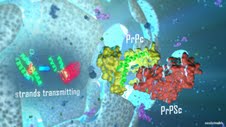Home > Press > Nanobotmodels create realistic prion propagation illustration: Nanobotmodels visualization studio creates education illustration of prion propagation mechanism
 |
Abstract:
Prions propagate by transmitting a misfolded protein state. If a prion enters a healthy organism, it induces existing, properly folded proteins to convert into the disease-associated, prion form; the prion acts as a template to guide the misfolding of more proteins into prion form. These newly formed prions can then go on to convert more proteins themselves; this triggers a chain reaction that produces large amounts of the prion form. All known prions induce the formation of an amyloid fold, in which the protein polymerises into an aggregate consisting of tightly packed beta sheets.
Nanobotmodels create realistic prion propagation illustration: Nanobotmodels visualization studio creates education illustration of prion propagation mechanism
Melitopol, Ukraine | Posted on August 9th, 2013The transmissible agent of prion disease consists of prion protein (PrP) in β-sheet-rich state (PrPSc) that can replicate its conformation according to a template-assisted mechanism. This mechanism postulates that the folding pattern of a newly recruited polypeptide accurately reproduces that of the PrPSc template.
Prion molecules are found at the cell surface, where they are anchored to the nerve cell membrane by short fatty acid molecules called glycosylphosphatidylinositols (GPIs), which are attached to the prions following synthesis of the proteins. Prions are, therefore, most likely to play a role (or roles) in some aspect of the cell-to-cell signalling process.
This illustration is the first step to full-length animation covering all prion transmitting mechanism - from delivery inside neuron until forming amyloid strands. This animation will be available this fall.
####
About Nanobotmodels Company
Nanobotmodels was established in 2007 with the goal of developing highly innovative, digital graphics to depict actual and conceptual technologies via the synergistic fusion of art and science. The still nascent, yet prospectively powerful discipline of nanotechnology is poised to radically transform medicine, engineering, biotechnology, electronics and myriad other sectors in the relative near-term. Hence, visionary artistic renderings that portray various aspects of this exciting nanofuture will be beneficial in facilitating a clear understanding of its fundamental concepts to a broad demographic.
Nanobotmodels generates imaginative and engaging state-of-the-art nanotechnology and nanomedical illustrations and animations. Any prototypical component, device, system or far flung concept that might be conceived of can be translated into captivating and colorful photorealistic animated or static renderings and presentation materials…. We bring them all to life for you!
For more information, please click here
Contacts:
common questions: info(at)nanobotmodels.com
sales and image permissions: sales(at)nanobotmodels.com
Copyright © Nanobotmodels Company
If you have a comment, please Contact us.Issuers of news releases, not 7th Wave, Inc. or Nanotechnology Now, are solely responsible for the accuracy of the content.
| Related News Press |
News and information
![]() Researchers develop molecular qubits that communicate at telecom frequencies October 3rd, 2025
Researchers develop molecular qubits that communicate at telecom frequencies October 3rd, 2025
![]() Next-generation quantum communication October 3rd, 2025
Next-generation quantum communication October 3rd, 2025
![]() "Nanoreactor" cage uses visible light for catalytic and ultra-selective cross-cycloadditions October 3rd, 2025
"Nanoreactor" cage uses visible light for catalytic and ultra-selective cross-cycloadditions October 3rd, 2025
Nanomedicine
![]() New molecular technology targets tumors and simultaneously silences two ‘undruggable’ cancer genes August 8th, 2025
New molecular technology targets tumors and simultaneously silences two ‘undruggable’ cancer genes August 8th, 2025
![]() New imaging approach transforms study of bacterial biofilms August 8th, 2025
New imaging approach transforms study of bacterial biofilms August 8th, 2025
![]() Cambridge chemists discover simple way to build bigger molecules – one carbon at a time June 6th, 2025
Cambridge chemists discover simple way to build bigger molecules – one carbon at a time June 6th, 2025
![]() Electrifying results shed light on graphene foam as a potential material for lab grown cartilage June 6th, 2025
Electrifying results shed light on graphene foam as a potential material for lab grown cartilage June 6th, 2025
Announcements
![]() Rice membrane extracts lithium from brines with greater speed, less waste October 3rd, 2025
Rice membrane extracts lithium from brines with greater speed, less waste October 3rd, 2025
![]() Researchers develop molecular qubits that communicate at telecom frequencies October 3rd, 2025
Researchers develop molecular qubits that communicate at telecom frequencies October 3rd, 2025
![]() Next-generation quantum communication October 3rd, 2025
Next-generation quantum communication October 3rd, 2025
![]() "Nanoreactor" cage uses visible light for catalytic and ultra-selective cross-cycloadditions October 3rd, 2025
"Nanoreactor" cage uses visible light for catalytic and ultra-selective cross-cycloadditions October 3rd, 2025
|
|
||
|
|
||
| The latest news from around the world, FREE | ||
|
|
||
|
|
||
| Premium Products | ||
|
|
||
|
Only the news you want to read!
Learn More |
||
|
|
||
|
Full-service, expert consulting
Learn More |
||
|
|
||








